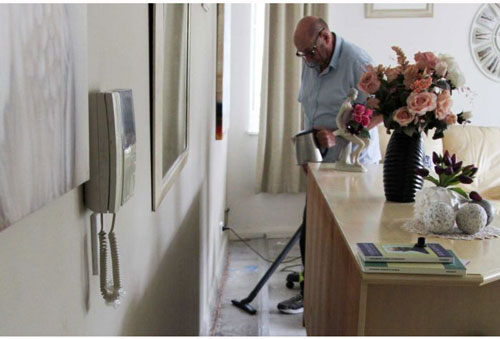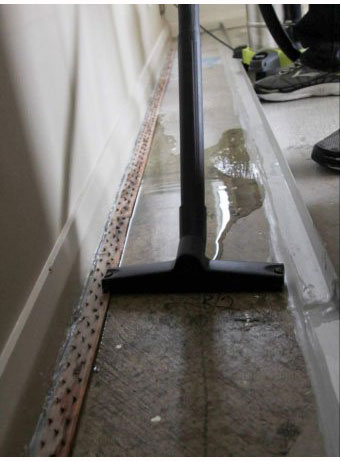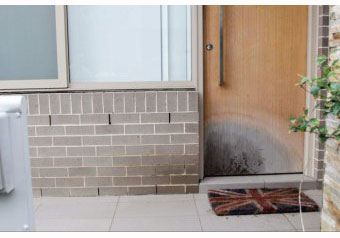Leaking buildings, mould and court battles: The dark side of the apartment boom
ABC News
By Tim Roxburgh
30 March 2016

Wentworth Point resident John demonstrates how his dam contains the rainwater from a leak. (ABC RN: Tim Roxburgh)
As apartments are built at a breakneck pace along Australia's east
coast, experts fear a coming glut of problem buildings that cannot keep
the rain out will trap many buyers in legal limbo.
In Sydney, one resident showed Background Briefing a dam in his living
room that he had installed while he waited out a long legal process.
Apartment owners can spend years fighting through the courts to recoup
repair costs, only to find out that the developer or builder has gone
bankrupt or has been placed into administration.
And while NSW's Fair Trading Commissioner is spruiking legal reforms
that will come into effect later this year, lawyers who represent
apartment owners say they do not go far enough.
From July 1, a developer or builder in NSW will have to set aside 2 per
cent of the construction cost of a project as a bond that can be
accessed later by residents if the builder or developer disappears.
Leaks have also been explicitly recognised as a "major defect", which
attracts a warranty period of six years. However, the bond can only be
claimed within two years of a building's completion.
"There are some checks and balances in there that weren't there before.
Let's be grateful for small mercies," said Suzi Broome, solicitor and
consultant with Sachs Gerace Broom.
"But really, 2 per cent? It's diddly squat. It's just insulting when
you compare how much money those innocent homeowners have to pay out."
Scale of problem unknown
No-one knows for sure how many apartments are defective or leaky, but
some figures indicate most new buildings have some kind of problem.
"Nobody keeps records of this stuff," said Bill Randolph, the director
of the City Futures Research Centre at the University of New South
Wales.
"Quite a lot of the defects don't get anywhere, they don't get to the
court, or owners just pay up and get on with it because they can't be
bothered to cover the cost of taking a builder to court."

Cracks in the render at Centenary Park in the Sydney suburb of Homebush West. (ABC RN: Tim Roxburgh)
A survey of strata owners conducted by the Research Centre in 2010
found that a startling 85 per cent of respondents in buildings built
since 2000 said their buildings were defective.
Professor Randolph said the respondents were self-selecting, and they
may have been more motivated to return the survey if they had problems.
But Ms Broome suggested that figure was close to the mark, saying that
if she had to estimate, she would guess around 70 per cent of new
buildings leak.
"That's a straw poll," she said. "It may be higher. Sadly I don't think it would be lower."
The living room with its own dam
Some people who've bought into new buildings in the past are struggling with major building problems.
John, who owns an apartment in Wentworth Point, a development near the
Parramatta River, said he had to vacuum 120 litres of rainwater off his
floor after a storm.
"I'd stop it, unplug it, take it out and drain it, and bring it back and start again to fill it up," John said.
John's apartment complex, called Palermo, was finished in 2007. The
owners found fire safety issues with the building soon after they moved
in, and later, in 2015, the building sprang some serious leaks.
The leak in John's apartment was so bad, he eventually had a small dam
installed in his living room as a stopgap measure. The dam is still
there today.

John vacuums water out of the dam in the living room of his apartment.
(ABC RN: Tim Roxburgh)
"That dam, about 100 litres would be contained in that. In hindsight, we probably needed to make the dam higher," he said.
The temporary measures were necessary while John waited out a long legal process.
The builder of the apartments had collapsed, negotiations with the
developer were going nowhere, and the owners had to gather complex
technical evidence in preparation for court.
Then, in February this year, almost three years after the owners
commenced legal action, the developer, Payce Properties, announced that
it was being placed into administration.
The parent company, Payce Consolidated, is still trading, and has plans
to roll out more than 7,000 more apartments in the next five years.
In a statement emailed to Background Briefing, the company said: "The
Palermo Owners' Corporation elected to pursue a course of litigation
rather than resolution.
"Payce was no longer prepared to waste time in litigation and spend
money on lawyers that should instead be spent on building defect
rectification.
"As has been the case since it was first advised of defect issues, Payce remains willing and able to address defects."
Leak described as 'maintenance issue'
Just one suburb over from John's house in Wentworth Point, residents in
a large new development called Centenary Park have already discovered
leaks, cracks and other building problems.
On a rainy day, Background Briefing witnessed several leaks in apartment buildings that are only three years old.

Water damage on the front door of a Centenary Park unit.
(ABC RN: Tim Roxburgh)
One couple, Kitty and Kevin, showed a large patch of sodden carpet in their bedroom.
They complained about the leak to the builder, who insisted that the leak was a maintenance issue.
"What can we do? Just keep sending emails," said Kevin.
There was a blockage, but also a leak. After Background Briefing visited the complex, the leak was fixed by the developer.
That developer's lawyer said it was "the result of improper or absent
maintenance on the part of the occupant" and that "the builder actively
responds to all claims, repairing legitimate claims, and providing
reasons in cases where the builder determines that the claim is not a
defect for which the builder is responsible".
Victorian builders warn of 'industry in crisis'
Concerns over the quality of new apartment buildings is not confined to NSW.
Victoria's Building Authority has labelled waterproofing a "possible
systemic issue" and announced that it is conducting an inquiry in
response to reports about "leaky building syndrome".
Phil Dwyer — a veteran builder based in Victoria, and the president of
the Builders Collective of Australia, which represents small builders —
said he had seen apartments that would make hair stand on end.

Cracking render on a garage driveway at Centenary Park.
(ABC RN: Tim Roxburgh)
"Just imagine the black blotching of of mould about 15 to 1,600
millimetres above the floor, the plaster you can put your finger
through, the carpet has actually grown grass on it," he said.
"We are of the opinion at that the moment that our industry is in
crisis ... there is no doubt that the next 10, 20 years is going to see
such a decline in the integrity of the building industry that it won't
be funny."
He said he decided to stop building apartments, because developers did not offer him enough money to do a proper job.
"Up until about September last year we've knocked back 17 apartment
buildings," he said. "And that's just one little builder here in
Melbourne."
top contents
chapter previous next




